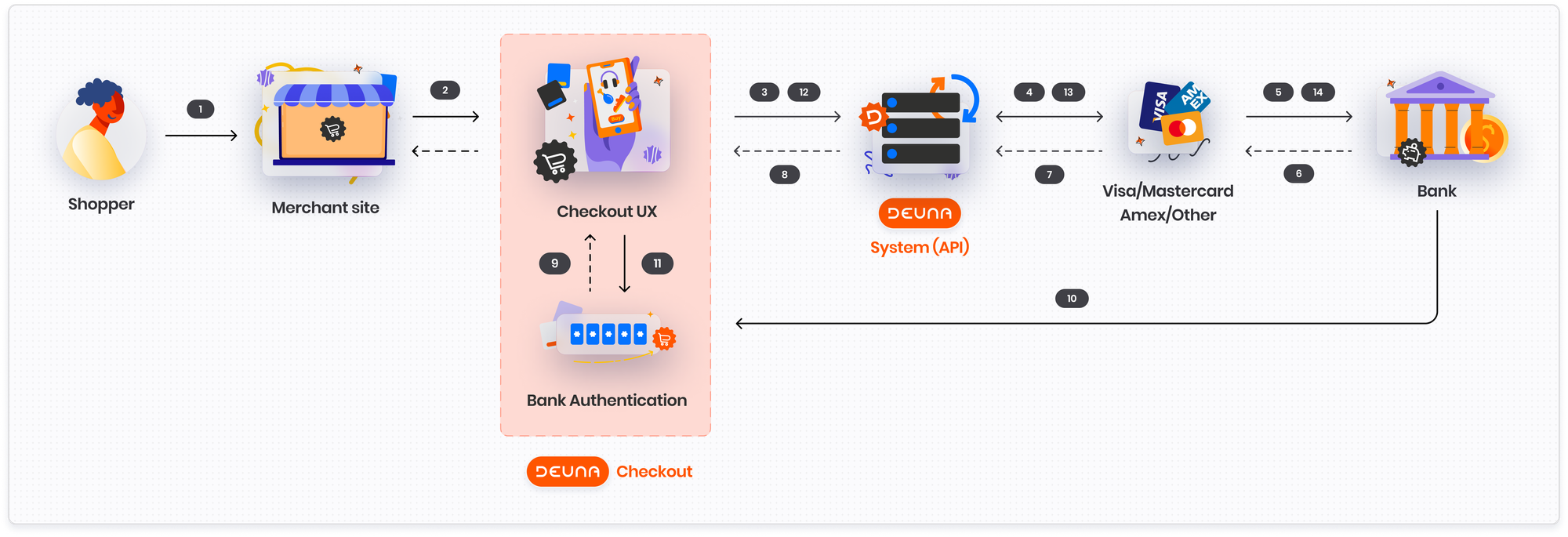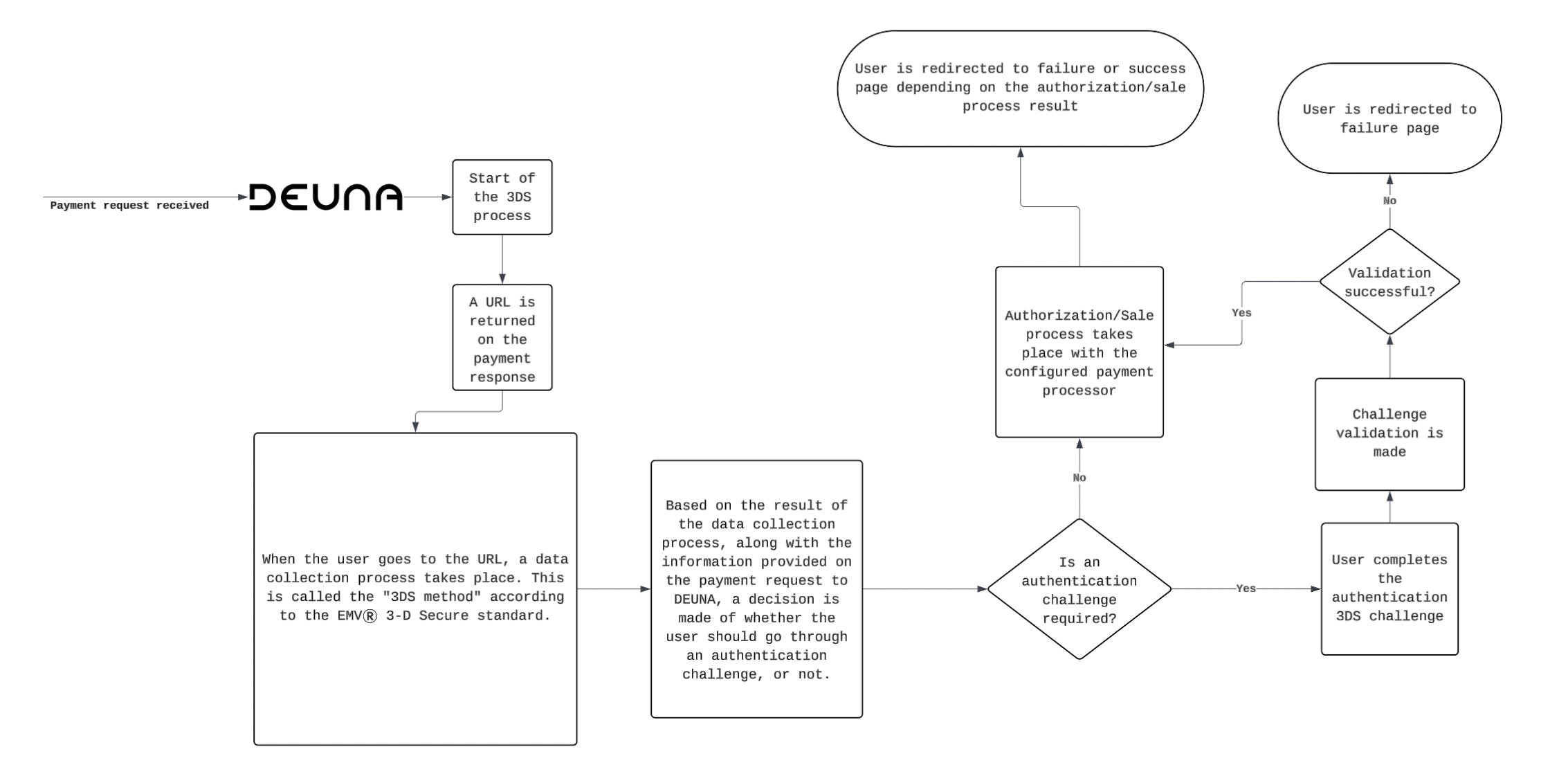3D Secure

What is 3DS
3DS is a security protocol designed to protect online transactions by authenticating the cardholder before the purchase is made, thus reducing the risk of fraud.
It is a fraud protection mechanism for merchants that enhances security when accepting credit card payments. 3DS stands for "three secure domains," where:
- The first domain is the card issuer.
- The second domain is the retailer receiving the payment.
- The third domain is the 3DS infrastructure platform that acts as a secure third party for both the consumer and retailer.
This functionality allows issuing banks to verify credit cardholders during the transaction process. This helps protect cardholders against fraud and transfers liability to merchants.
How does 3DS work?
3DS adds an additional layer of security to online credit and debit card transactions.
Typically, during payment, the cardholder accesses an authentication page on their bank's website and enters a password associated with the card or a code sent to their phone.
When a cardholder successfully authenticates, fraud liability shifts from the merchant to the cardholder, meaning the merchant is not responsible for such payments.
A purchase with 3DS follows these steps:
- The merchant's payment process collects client information such as billing, shipping, and card information, and sends the data for payment authorization.
- The payment service provider determines whether 3DS should be required for the payment.
- If 3DS is required, then the customer is automatically redirected to their bank's website to authenticate the payment. At that point, the bank might determine to authenticate the payment without requiring more information or may ask the customer to authenticate the payment by entering a unique code sent by the bank. Providing more customer information, such as billing and shipping, increases the likelihood that the bank automatically authenticates the payment instead of requiring the customer to provide a unique code sent by the bank.
- After authentication, the customer is automatically redirected to the merchant's website, at which point the payment is completed.
3DS flow diagram

Steps:
- The buyer clicks a button on the merchant's site to pay for a purchase.
- The merchant's website displays DEUNA's checkout.
- The buyer enters credit card credentials and submits the payment.
- DEUNA's system communicates with card associations (Visa/MasterCard/Others) to authorize the payment.
- Card associations communicate with the card's issuing bank.
- The card's issuing bank requests 3DS along with a URL for the buyer to use to authenticate the payment and sends an OTP directly to the buyer.
- Card associations transmit that request to DEUNA along with the URL.
- DEUNA's system returns the URL to DEUNA's checkout along with instructions to authenticate the payment.
- DEUNA's payment uses the URL to display the bank's authentication page without having to leave the buyer's website.
- The buyer authenticates the payment using the OTP that the bank sent directly to the buyer.
- Control is returned to DEUNA.
- DEUNA's payment process then communicates with DEUNA's system to complete the payment and provides proof of authentication.
- DEUNA's system reviews the information and communicates with card associations to complete the payment by providing proof of authentication.
- Card associations complete the payment with the issuing bank by providing the issuing bank's information.
Benefits
- Unified integration: A single integration point for 3DS across multiple acquirers
- Consistent experience: Provides a consistent user experience for 3DS authentication
- Higher conversion: Authentication flow optimization to improve conversion rates
- Broad compatibility: Works with processors that accept externally generated 3DS values
With our 3DS MPI you can transact either through a direct API integration, using the payment widget, or the payment link.
DEUNA's 3DS MPI
3DS MPI (3D Secure Merchant Plugin Interface) is a DEUNA solution that provides a 3D Secure authentication service independent of payment processors.
This functionality allows merchants to use a single 3DS provider across multiple acquirers, simplifying integration and improving user experience.
General flow with DEUNA's 3DS MPI

Data collection process
In order to achieve a smoother and frictionless user experience, we collect data from their browser and device to make a more accurate decision about sending a challenge to the user or not. Specifically, we collect the following data:
- The user's screen color depth
- The user's browser
javaEnabledproperty - The user's browser UI language
- Screen dimensions
- User's time zone
- The browser's "user agent" value
Considerations when using DEUNA's 3DS MPI
- 3DS MPI configuration is specific per acquirer.
- For transactions that fail for reasons other than 3DS, it might be necessary to restart the authentication process.
Processors that support 3DS MPI
- Unlimit
- Adyen
- Amex
- Elavon
- BAZ
- MIT Bulk
- Cybersource
- Kushki
- Worldpay
- Mercado Pago
- Globalpay
- Nuvei
- Placetopay
- PayU
- Cielo
- Getnet
Currencies and countries supported by 3DS MPI
Currently, DEUNA 3DS supports Mexican Pesos (MXN), Dollar (USD), Euro (EUR), Yen (JPY), Colombian Pesos (COP), Peruvian Soles (PEN) and Brazilian Reales (BRL).
More currencies will be eventually added to 3DS DEUNA.
Networks supported by 3DS MPI
DEUNA's 3DS MPI supports major card brands:
- Mastercard
- Visa
- American Express
To ensure compatibility with other brands, confirm with your DEUNA point of contact during the integration process.
Required data to ensure proper functioning of 3DS MPI
| Field name | Type | Length | Comments |
|---|---|---|---|
| currency | string | 3 | ISO 3166-1 alpha-3 |
| order.items.total_amount.amount | string | 15 (max) | |
| order.billing_address.address1 | string | 40 (max) | |
| order.billing_address.state_name | string | 3 | ISO 3166-2 |
| order.billing_address.country | string | 2 | Use a two-character ISO country code. |
| order.billing_address.city | string | 50 (max) | |
| order.billing_address.first_name | string | 40 (max) | |
| order.billing_address.last_name | string | 40 (max) | |
| order.billing_address.phone | string | 15 (max) | The format should be "+{country_code}{phone_number}" |
| order.billing_address.email | string | 255 (max) | Email format |
| order.billing_address.zipcode | string | 9 (max) |
Test cards to simulate 3DS flows in sandbox environment
| Case | Card Number | CVV / Expiration Date |
|---|---|---|
| Successful challenge | 4000000000002503 | Any |
| Failed challenge | 4000000000002370 | Any |
| Successful frictionless | 4000000000002701 | Any |
| Failed frictionless | 4000000000002925 | Any |
3DS status codes
Validate the status of a 3DS purchase with its respective status code:
- For United States (US), Canada (CA), and China (CN), the
state_codefield must be provided according to the ISO 3166-2 standard. - If a merchant is unable to send the state code following this format, they can enable automatic validation in the Admin by navigating to Merchant → Payment Settings and activating the option “Validate the state_code field according to ISO 3166-2”.
- When this option is enabled, if the merchant does not send the
state_codeor sends it in an invalid format for US, CA, or CN, DEUNA will validate the field and send a standardized value. - Even if the merchant is already sending the field in the correct format, the validation option can still be enabled as an additional safeguard.
- To perform this validation, the merchant must provide the ZIP code. Using this information, DEUNA can determine the corresponding state code.
- DEUNA does not guarantee successful state code enrichment in all cases. If the ZIP code is invalid or cannot be matched, the field may not be populated.
Updated about 1 month ago
